| Pages:
1
2
3 |
bledito
Nomad
 
Posts: 420
Registered: 7-6-2013
Member Is Offline
|
|
Air down tires
What is the reasoning behind air down of tires? Is it to make them softer less prone to punctures and tears? Is it to provide more mass at ground
contact for better traction? what is the purpose?
|
|
|
David K
Honored Nomad
        
Posts: 65266
Registered: 8-30-2002
Location: San Diego County
Member Is Offline
Mood: Have Baja Fever
|
|
Yes.... primarily we air down to not get stuck in sand... usually in the 10-20 psi range depending on what kind of tires and what kind of sand.
The next reason is to prevent flats on Baja chipped rocks roadbeds (graded roads)... usually in the 20-25 psi range to keep the sharp rocks from
piercing the tires. This also makes a more comfortable ride.
Another reason is to improve climbing traction off road, also around 15-20 psi. Softer tires can bite much better!
|
|
|
David K
Honored Nomad
        
Posts: 65266
Registered: 8-30-2002
Location: San Diego County
Member Is Offline
Mood: Have Baja Fever
|
|
Here is a steep beach, sea shells, sand, gravel and wet... my truck is loaded and heavy. See how it is sinking and drifting as I try to drive straight
with tires at street pressure (38 psi):
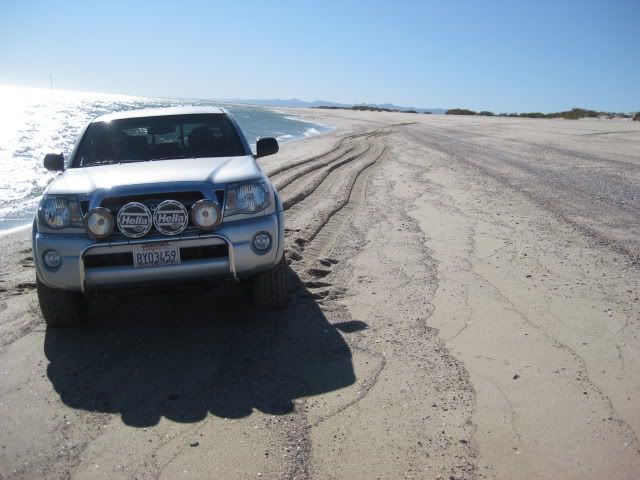
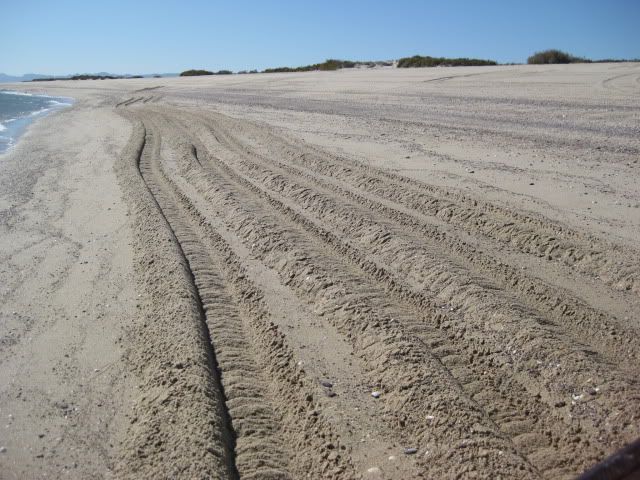
Dry sand is even harder to drive on without deflating.
Now, after dropping the pressure 50% (to 19 psi), the truck floats on top and drives with ease...
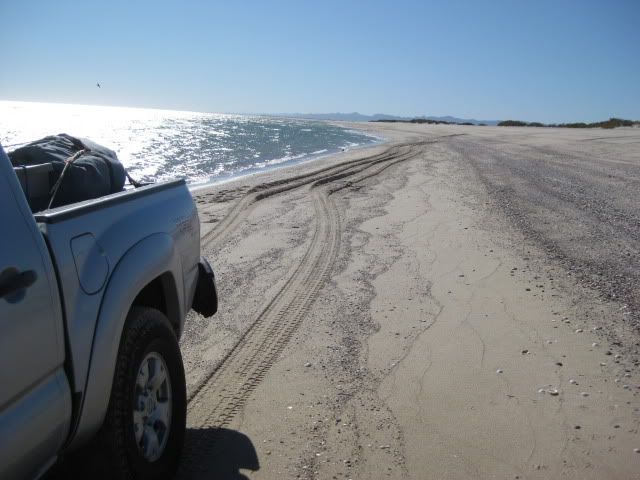
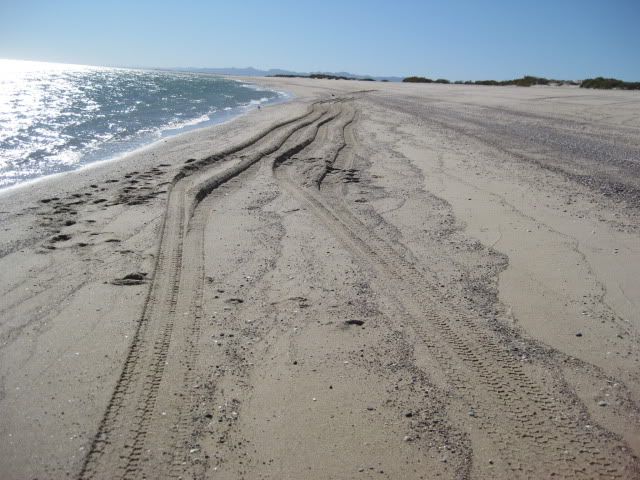
I only recently began to deflate for graded dirt roads, and I got lots of flats from sharp rocks by not deflating and being in a hurry (or driving
fast because it is fun in a Tacoma).
|
|
|
Barry A.
Select Nomad
      
Posts: 10007
Registered: 11-30-2003
Location: Redding, Northern CA
Member Is Offline
Mood: optimistic
|
|
I think that David's "air down" advice is right on target, but essentially for light rigs. On the heavier camper-type rigs be very careful that you
have adequate pressure to handle the load you have-------too low and the tires will overheat and fail, or experience rim-cuts when rocks collapse the
tire and pinch it between rim and rocks..
Bigger (wide and tall) tires also seem to handle the lower pressures better than narrow tires in my experience.
Bottom line--------with heavy rigs its kinda tricky finding the "right" air pressure, so be careful.
Barry
|
|
|
StuckSucks
Super Nomad
   
Posts: 2359
Registered: 10-17-2013
Member Is Offline
|
|
One more word of caution. When you air down, the sidewall bulge out - just want you want for soft sand. But that bulging sidewall is vulnerable to
damage from rocks - be mindful when driving with low tires.
|
|
|
David K
Honored Nomad
        
Posts: 65266
Registered: 8-30-2002
Location: San Diego County
Member Is Offline
Mood: Have Baja Fever
|
|
Another before and after photo:
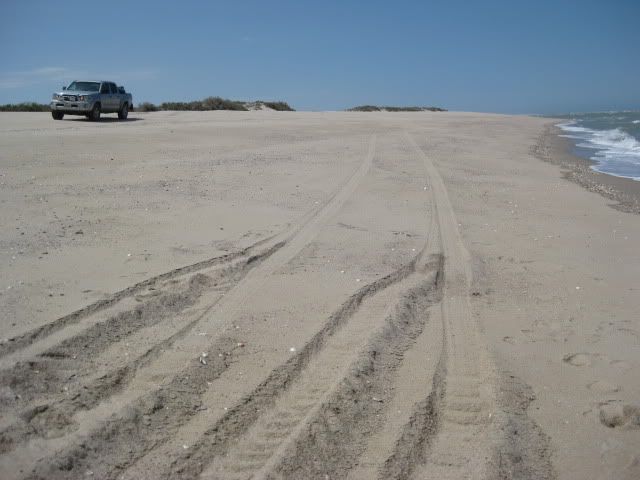
Speaking of heavy truck tires... Here is Art's 4WD van/ motorhome on Shell island when he tried front and rear lockers, but not deflating enough air:
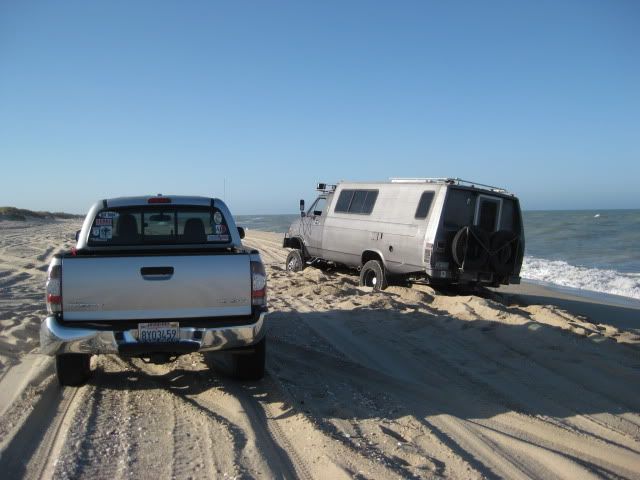

Ken Cooke gives a hand!
Once he let out MORE air, Art got floatation, and he was HAPPY!...
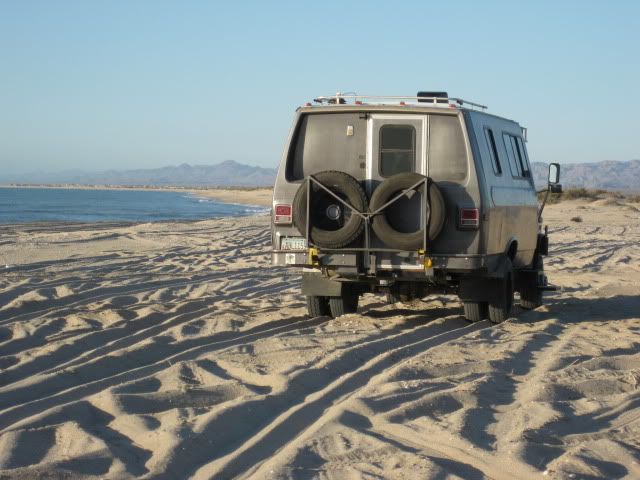
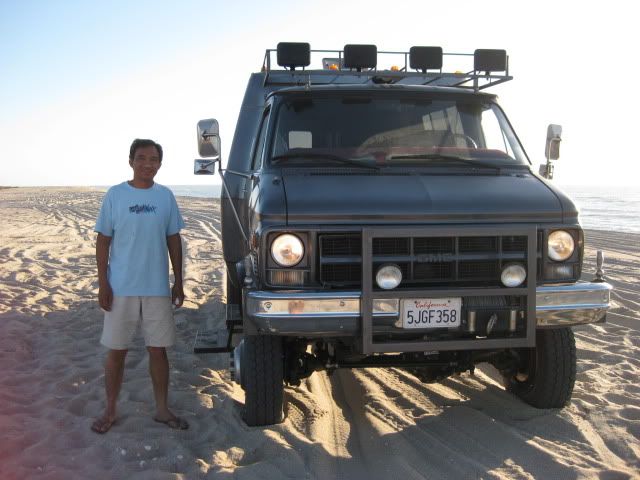
On dry soft sand, no problem at 15-20 psi (and 4WD of course):
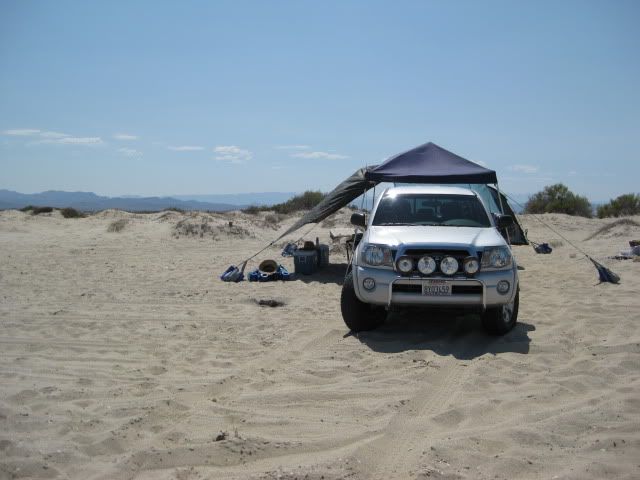
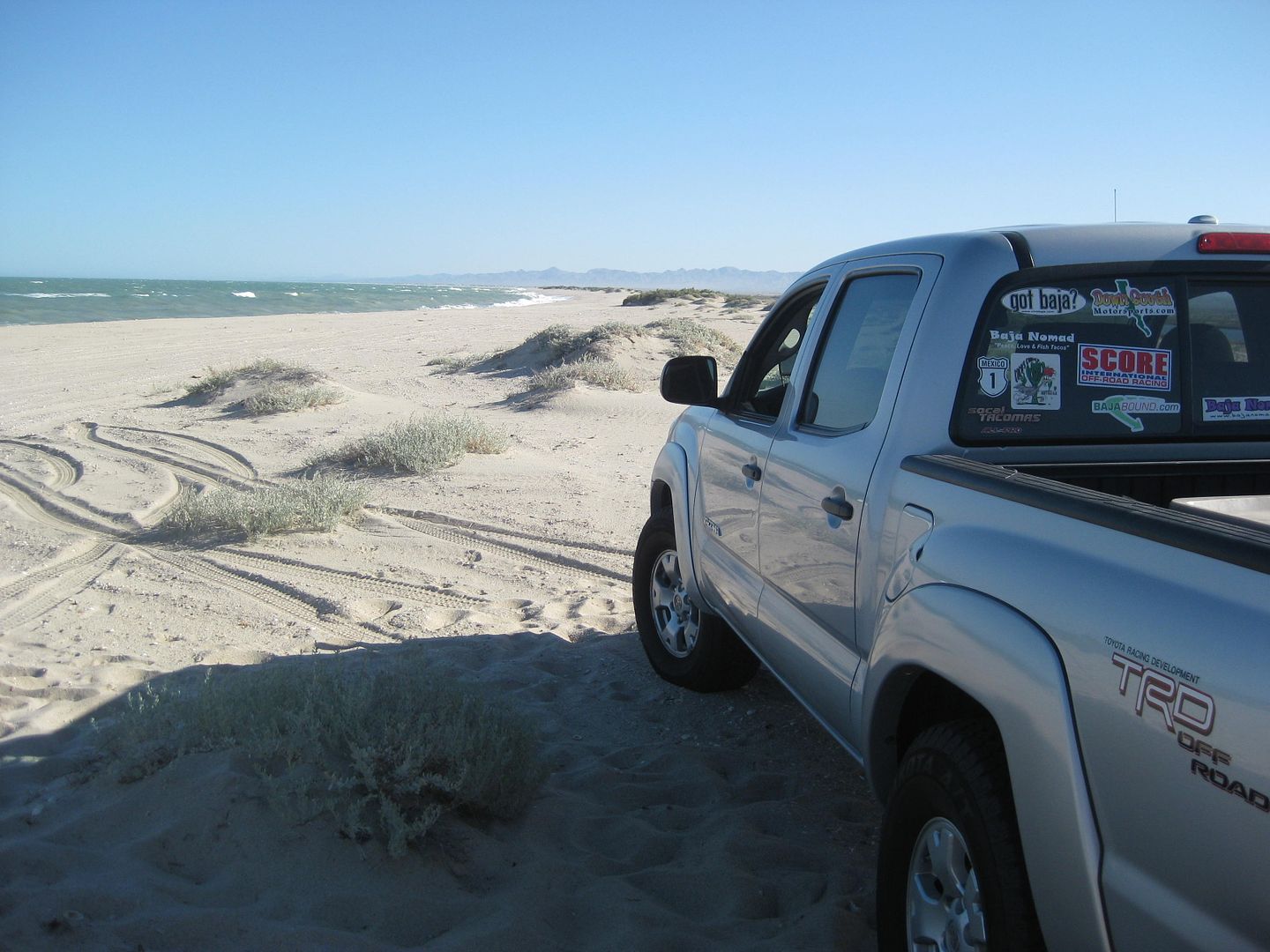
Even with just 2WD, if you let enough air out, you will float on the sand!
Obviously you don't want to pop off the rim, so 8 psi is likely the absolute bottom range without bead lockers, and don't brake or turn suddenly,
don't drive fast but keep up momentum.
|
|
|
dizzyspots
Senior Nomad
  
Posts: 603
Registered: 9-22-2008
Location: Mescal AZ
Member Is Offline
Mood: rather be on the beach at Gonzaga
|
|
Over at www.expeditionportal.com an archived article discussed a more scientific way for airing down....
The suggestion was to load the vehicle as you would normally run it..with the standard hiway tire air pressure.
A) Measure the side wall height ....do the math to get 75% of that height ( ex: 4 inches x 75% is 3 inches)
b) Lower the air pressure just until you reach that sidewall height...make note of that PSI...reinflate to proper PSI
c) That lower psi should be your target PSI for airing down
Make sense?
|
|
|
J.P.
Super Nomad
   
Posts: 1673
Registered: 7-8-2010
Location: Punta Banda
Member Is Offline
Mood: Easy Does It
|
|
Air Down
Airing down tires can sometimes be a Slippery Slope. As if a tire fails because of a Side Wall Break Down it usually Voids the Tire Warranty
|
|
|
ehall
Super Nomad
   
Posts: 1906
Registered: 3-29-2014
Location: Buckeye, Az
Member Is Offline
Mood: It's 5 o'clock somewhere
|
|
It sures smooths out the ride thru rocks when I put the 35" tires on my jeep down to 12 pounds. Alot easier on the body.
|
|
|
dizzyspots
Senior Nomad
  
Posts: 603
Registered: 9-22-2008
Location: Mescal AZ
Member Is Offline
Mood: rather be on the beach at Gonzaga
|
|
and also the sidewall height of the tires that allows for more flotation...a similar article showed graphic examples of taller tires vs wide
tires...the extra flotation is a function of an elongated tread..a longer footprint as opposed to simply a wider footprint....so a 265/75-16 when
deflated would have better flotation than say a 265/70-16
[Edited on 3-2-2015 by dizzyspots]
|
|
|
David K
Honored Nomad
        
Posts: 65266
Registered: 8-30-2002
Location: San Diego County
Member Is Offline
Mood: Have Baja Fever
|
|
Been airing down since I was 16 (1974) on all sorts of vehicles and all sorts of tires... never had a sidewall fail. However, if you aren't smart and
don't bother to air back up when you leave the beach, that would be dumb! In the old days, we had an air pump that replaced a spark plug while
filling. In the 80's we used a cigarette lighter pump... took a while, but no hot parts to remove/ replace... the past few years, a battery connected
pump... muy rapido!
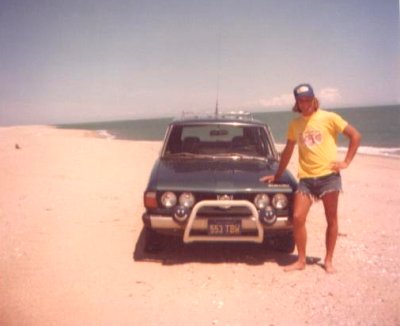
My Subaru with little 13" tires floating on Shell Island's sand like a dune buggy in 1978 (I was 20)... 10 psi was the magic pressure for those tires
in the sand.
|
|
|
ncampion
Super Nomad
   
Posts: 1238
Registered: 4-15-2006
Location: Loreto
Member Is Offline
Mood: Retired and Loving it
|
|
Here's another question about airing down tires. We often launch an aluminum boat off the beach and a friend is telling me to air down the trailer
tires to make it easier to launch/retrieve the trailer. It seems to me that it is not a good idea to air down trailer tires as this gives them more
rolling resistance through the sand. I can see having a bigger footprint on drive wheels for traction, but not sure it makes sense on towed wheels.
What are the thoughts on that?
Living Large in Loreto. Off-grid and happy.
|
|
|
David K
Honored Nomad
        
Posts: 65266
Registered: 8-30-2002
Location: San Diego County
Member Is Offline
Mood: Have Baja Fever
|
|
Surprisingly yes, it does help to also air down non powered tires. Floating on top vs. 'knifing' into the sand...
|
|
|
ncampion
Super Nomad
   
Posts: 1238
Registered: 4-15-2006
Location: Loreto
Member Is Offline
Mood: Retired and Loving it
|
|
OK, I'll try it next time and see what happens.
Living Large in Loreto. Off-grid and happy.
|
|
|
willardguy
Elite Nomad
     
Posts: 6451
Registered: 9-19-2009
Member Is Offline
|
|
Quote: Originally posted by dizzyspots  | Over at www.expeditionportal.com an archived article discussed a more scientific way for airing down....
The suggestion was to load the vehicle as you would normally run it..with the standard hiway tire air pressure.
A) Measure the side wall height ....do the math to get 75% of that height ( ex: 4 inches x 75% is 3 inches)
b) Lower the air pressure just until you reach that sidewall height...make note of that PSI...reinflate to proper PSI
c) That lower psi should be your target PSI for airing down
Make sense? |
I like it! now were they talking about just sand or all conditions?
|
|
|
elgatoloco
Ultra Nomad
    
Posts: 4346
Registered: 11-19-2002
Location: Yes
Member Is Offline
|
|
Quote: Originally posted by dizzyspots  | Over at www.expeditionportal.com an archived article discussed a more scientific way for airing down....
The suggestion was to load the vehicle as you would normally run it..with the standard hiway tire air pressure.
A) Measure the side wall height ....do the math to get 75% of that height ( ex: 4 inches x 75% is 3 inches)
b) Lower the air pressure just until you reach that sidewall height...make note of that PSI...reinflate to proper PSI
c) That lower psi should be your target PSI for airing down
Make sense? |
Science? 
Thanks for the link. I will check it out and see how it compares to my personal observations and trail and error. 
MAGA
Making Attorneys Get Attorneys
|
|
|
bledito
Nomad
 
Posts: 420
Registered: 7-6-2013
Member Is Offline
|
|
so now i am informed, thanks. will start doing this in future off road. what is the suggested maximum speed with them aired down?
|
|
|
willardguy
Elite Nomad
     
Posts: 6451
Registered: 9-19-2009
Member Is Offline
|
|
Quote: Originally posted by bledito  | | so now i am informed, thanks. will start doing this in future off road. what is the suggested maximum speed with them aired down?
|
hey do yourself a big favor and buy a set of automatic deflaters, set em for the PSI you want, screw em on and crack a cold one. well worth the
investment!
|
|
|
David K
Honored Nomad
        
Posts: 65266
Registered: 8-30-2002
Location: San Diego County
Member Is Offline
Mood: Have Baja Fever
|
|
Quote: Originally posted by bledito  | | so now i am informed, thanks. will start doing this in future off road. what is the suggested maximum speed with them aired down?
|
In sand, you will drive what feels comfortable to you, but usually not over 35 mph... in high range 4WD... usually slower as we go along looking for
shells and critters to photograph. When deflated, and to keep from getting stuck, you drive in wider arches, no sharp turns... roll to a stop don't
hit the brakes. Avoid digging in. If your tires spin when you try to move forward, they have too much air in them. You will need a good dial air gauge
that reads below 10 psi for accurately deflating, even if you never go below 15 psi.
The auto deflators Willard mentions are interesting, but I think they are expensive (?), so have always used a small screwdriver or pointy shell to
depress the schrader (air) valve in the stem.
Here is one brand for $69: http://www.justforjeeps.com/autide.html?gclid=Cj0KEQiAsdCnBR...
|
|
|
AKgringo
Elite Nomad
     
Posts: 6198
Registered: 9-20-2014
Location: Anchorage, AK (no mas!)
Member Is Offline
Mood: Retireded
|
|
Chalk your tires!
This advice is for fairly light vehicles, with oversize tires running on pavement. With your vehicle and/or trailer loaded the way you intend to
travel, find a large dry patch of asphalt. Draw a chalk line across each tire and drive in a straight line and observe how the chalk wears off. If
the outside edges wears first, increase the pressure. If the center wears faster, drop the pressure.
The chalk will wear off immediately and show you how the rubber will wear in a few thousand miles! You may find that each axle is different, and you
might observe uneven wear indicating alignment or worn part issues.
My SUV is light, and camp trailer is even lighter, so I run 26 psi on the car, and 12 on the trailer (same tires all around).
Off road I will go down to half those pressures, and so far have not done any sidewall damage or had a bead leak. I don't drive any farther than I
have to aired down, and never at highway speeds. If you have been making good time, get out and put your hand on the sidewalls to see how much heat
is being created by the abnormal flexing at low pressures.
Yes to the question of low pressure on the trailer tire, it is the difference between dragging a roller or a spade. But if you have little bitty
wheels and tires, you are still going to have problems.
If you are not living on the edge, you are taking up too much space!
"Could do better if he tried!" Report card comments from most of my grade school teachers. Sadly, still true!
|
|
|
| Pages:
1
2
3 |

